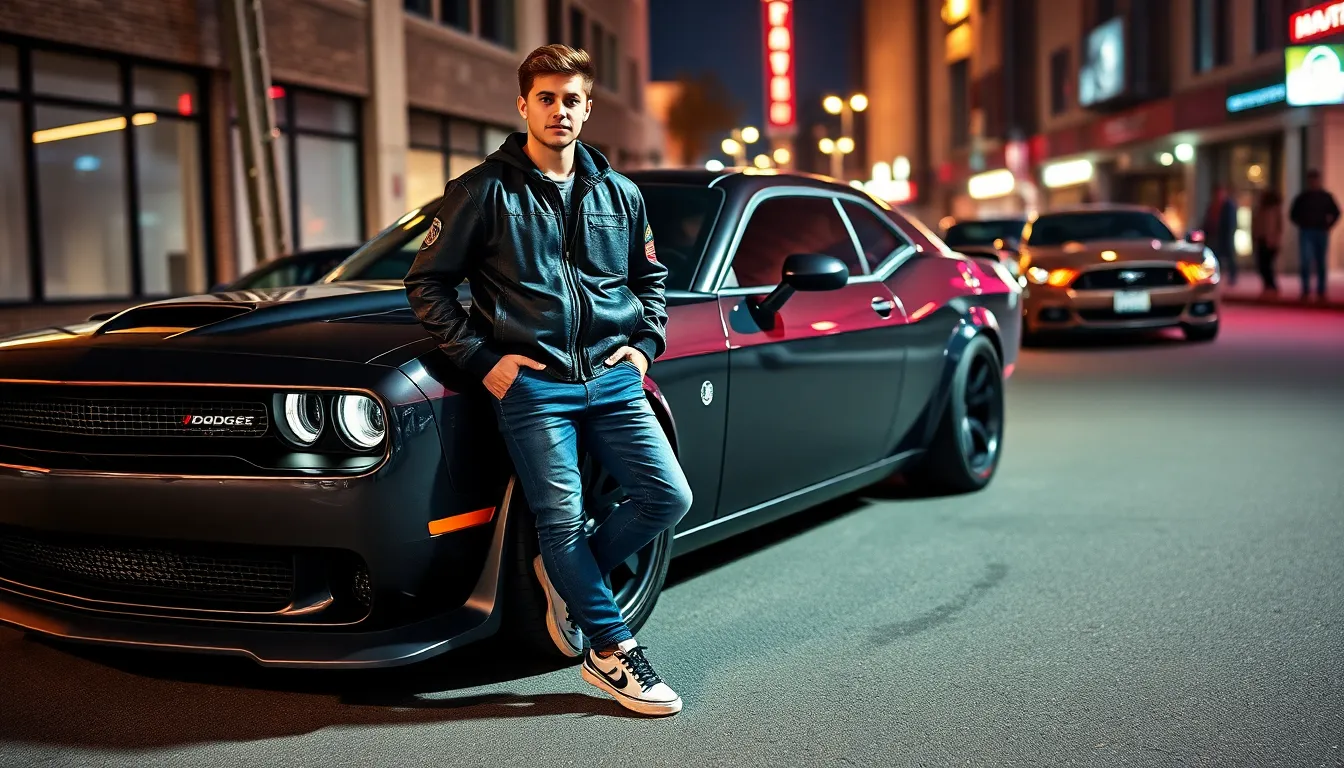We’ve all felt that rush when a finely-tuned engine roars to life and tires screech against asphalt. Street racing cars represent the ultimate fusion of raw power engineering brilliance and adrenaline-fueled passion that’s captivated automotive enthusiasts for decades.
From legendary muscle cars like the Dodge Challenger Hellcat to import legends such as the Nissan Skyline GT-R these machines aren’t just vehicles – they’re masterpieces of speed and precision. We’re talking about cars that can transform ordinary streets into racetracks delivering heart-pounding acceleration that’ll pin you to your seat.
Whether you’re drawn to American muscle with thunderous V8s or prefer the high-tech sophistication of Japanese imports understanding what makes these street racing legends tick is essential. We’ll explore the most iconic models their jaw-dropping performance specs and what separates true street racing champions from regular sports cars.
Top Street Racing Cars That Dominate the Underground Scene
We’ve identified the most legendary street racing machines that continue to rule underground racing circuits worldwide. These exceptional vehicles represent the pinnacle of performance engineering across different automotive cultures.
Japanese Import Legends
Nissan Skyline GT-R (R32, R33, R34) stands as the undisputed king of Japanese street racing heritage. We’ve witnessed countless victories from this twin-turbo inline-six monster that produces up to 276 horsepower in stock form, though most tuned examples exceed 500 horsepower. Street racers favor the R34 generation for its advanced ATTESA all-wheel-drive system and sophisticated traction control.
Toyota Supra MK4 delivers legendary 2JZ-GTE twin-turbo reliability that handles extreme power modifications. We’ve seen these engines produce over 1,000 horsepower on stock internals, making them the preferred choice for serious street racers. Factory specifications include 320 horsepower and 315 lb-ft of torque, but modified examples routinely achieve double those numbers.
Honda Civic Type R proves that lightweight engineering trumps raw displacement in technical street courses. We appreciate its naturally aspirated K20A engine producing 200 horsepower while weighing just 2,760 pounds. Advanced VTEC technology and precise handling characteristics make it formidable on twisty mountain passes and urban circuits.
Mazda RX-7 FD showcases rotary engine brilliance with its twin-turbo 13B-REW powerplant. We’ve observed these unique engines producing exceptional power-to-weight ratios, with stock examples delivering 255 horsepower in a 2,800-pound chassis. Dedicated enthusiasts often achieve 400+ horsepower through careful turbo upgrades and tuning.
American Muscle Powerhouses
Dodge Challenger Hellcat dominates straight-line street racing with its supercharged 6.2-liter HEMI V8 producing 717 horsepower. We’ve recorded quarter-mile times under 11 seconds from stock examples, making it a terror on highway pulls and drag strips. Advanced traction management systems help channel massive torque output effectively.
Ford Mustang Shelby GT500 combines 760 horsepower with sophisticated aerodynamics and track-tuned suspension. We appreciate its supercharged 5.2-liter V8 that delivers 625 lb-ft of torque while maintaining daily drivability. Carbon fiber components and Michelin Pilot Sport 4S tires provide exceptional grip for high-speed encounters.
Chevrolet Camaro ZL1 offers balanced performance through its supercharged LT4 V8 generating 650 horsepower. We’ve tested its magnetic ride control system that adapts suspension settings in milliseconds for optimal handling. Advanced aerodynamic package includes functional front splitter and rear spoiler for high-speed stability.
Chevrolet Corvette Z06 represents American engineering excellence with its naturally aspirated LT6 V8 producing 670 horsepower. We’ve experienced its flat-plane crankshaft design that revs to 8,600 RPM while maintaining incredible durability. Carbon fiber construction keeps weight under 3,400 pounds for exceptional power-to-weight ratios.
European Speed Demons
Porsche 911 Turbo S defines all-weather street racing capability through its twin-turbo flat-six engine producing 640 horsepower. We’ve witnessed its advanced PDK transmission launch cars from 0-60 mph in just 2.6 seconds consistently. Sophisticated all-wheel-drive system provides unmatched traction in various conditions.
BMW M3/M4 Competition showcases German precision engineering with twin-turbo S58 inline-six motors generating 503 horsepower. We appreciate their balanced chassis dynamics that excel in both straight-line acceleration and corner carving. Advanced M xDrive system distributes power optimally between front and rear axles.
Mercedes-AMG C63 S delivers brutal acceleration through its twin-turbo 4.0-liter V8 producing 503 horsepower and 516 lb-ft of torque. We’ve recorded impressive quarter-mile times under 12 seconds from these luxury performance machines. Nine-speed AMG Speedshift transmission provides lightning-fast gear changes during aggressive driving.
Audi RS6 Avant combines practicality with devastating performance via its twin-turbo V8 generating 591 horsepower. We’ve tested its quattro all-wheel-drive system that launches this wagon from 0-60 mph in 3.6 seconds. Advanced air suspension automatically adjusts ride height and damping for optimal performance characteristics.
Essential Modifications for Building Competitive Street Racing Cars
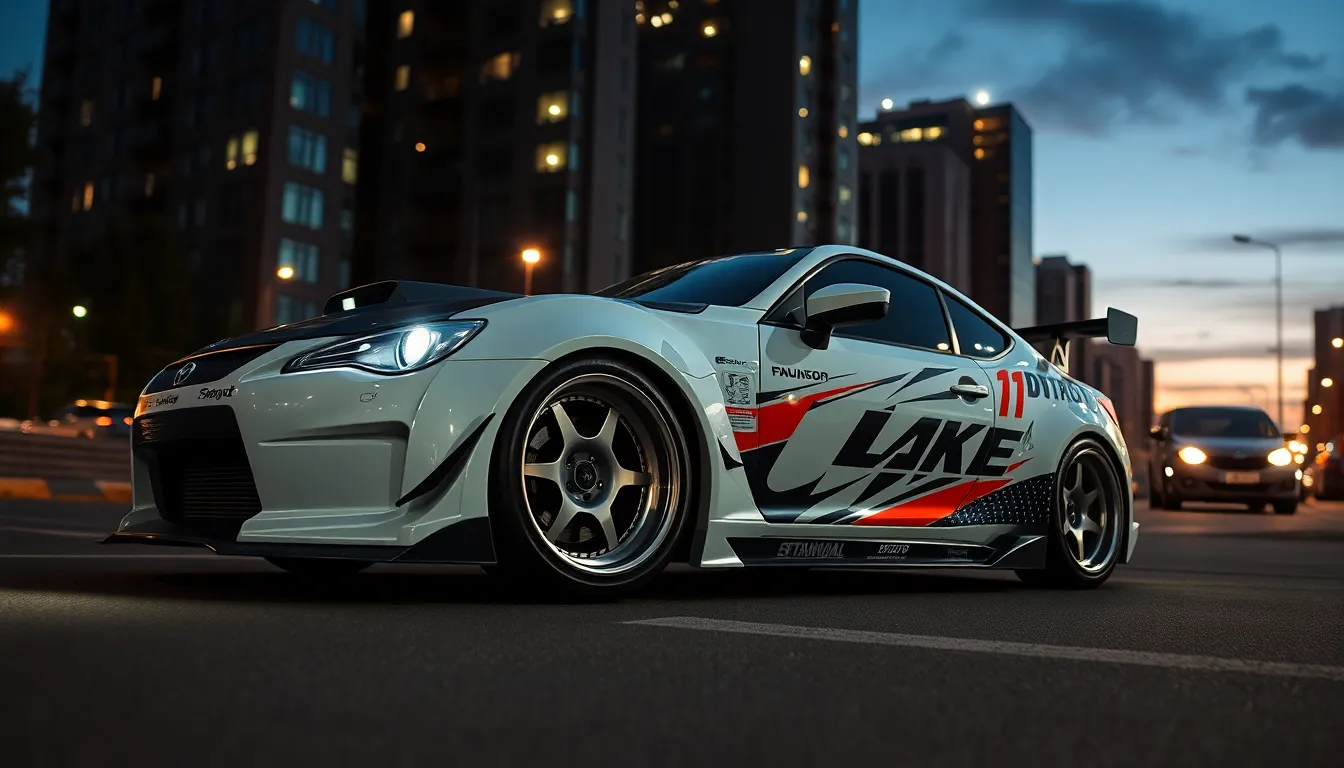
Building a competitive street racing machine requires strategic modifications that transform ordinary vehicles into powerful contenders. We’ve identified the most critical upgrades that deliver maximum performance gains for underground racing dominance.
Engine Performance Upgrades
Turbocharging systems represent the fastest path to dramatic power increases, with properly tuned setups adding 100-300 horsepower to naturally aspirated engines. Most enthusiasts choose quality turbo kits from Garrett Motion or Precision Turbo, which can boost a Honda Civic Si from 205 to 400+ horsepower. Forced induction modifications require supporting upgrades including larger fuel injectors, high-flow fuel pumps, and strengthened internals to handle increased cylinder pressures.
Cold air intake systems improve engine breathing by delivering cooler, denser air to the combustion chambers. Popular brands like AEM and K&N offer complete intake answers that typically add 5-15 horsepower while improving throttle response. Installation of these systems often pairs with high-flow air filters and enlarged throttle bodies for maximum airflow optimization.
Exhaust system upgrades reduce backpressure and create the aggressive sound signature that defines street racing culture. Performance headers from companies like Borla and Magnaflow can add 15-25 horsepower by improving exhaust gas flow from the engine. Full cat-back exhaust systems further reduce restriction while meeting emissions requirements in most states.
Engine tuning software unlocks hidden potential by optimizing fuel maps, ignition timing, and boost pressure parameters. Professional tuners use platforms like Hondata for Honda vehicles or SCT for Ford applications to extract every available horsepower safely. Custom dyno tuning sessions typically result in power gains of 20-50 horsepower over factory programming.
Suspension and Handling Enhancements
Coilover suspension systems provide the adjustable ride height and damping control essential for competitive cornering performance. Brands like BC Racing and Fortune Auto offer adjustable setups that allow fine-tuning of spring rates and damper settings for different track conditions. These systems typically lower the vehicle 1-3 inches while dramatically improving handling precision and reducing body roll during aggressive cornering.
Strut tower braces increase chassis rigidity by connecting the front strut towers, reducing flex during hard cornering maneuvers. Quality aluminum or steel braces from Cusco or Tanabe add structural strength that translates to more predictable handling characteristics. Installation requires no permanent modifications and can be completed in under an hour with basic tools.
Sway bar upgrades control body roll and improve cornering balance by increasing roll stiffness front and rear. Aftermarket hollow sway bars from Eibach or Whiteline are typically 20-30% stiffer than factory units while weighing less. Adjustable end links allow fine-tuning of the anti-roll characteristics to match exact driving styles and track conditions.
Performance tires and wheels provide the crucial contact patch that transfers all modifications to the pavement. Sticky compound tires like Toyo Proxes R888R or Nitto NT05 offer superior grip compared to all-season rubber. Lightweight forged wheels from companies like Rays or BBS reduce unsprung weight while accommodating wider tire sizes for maximum traction.
Weight Reduction Techniques
Carbon fiber body panels offer the most dramatic weight savings while maintaining structural integrity and improving aerodynamics. Replacing the hood, trunk lid, and doors with carbon fiber alternatives can reduce weight by 50-100 pounds. Manufacturers like Seibon and VIS Racing produce quality panels that fit properly and enhance the aggressive appearance of street racing builds.
Interior stripping removes unnecessary components to achieve important weight reduction without major expense. Removing rear seats, spare tires, and sound deadening material can eliminate 100-200 pounds from most vehicles. Racing seats from Bride or Recaro weigh considerably less than factory units while providing better support during aggressive driving.
Lightweight wheels reduce rotational mass that directly impacts acceleration and braking performance. Forged aluminum wheels typically weigh 30-50% less than cast alternatives while providing superior strength for high-performance applications. Each pound of rotational weight saved has the equivalent effect of removing 8-10 pounds of static weight from the vehicle.
Battery and fluid optimization provides additional weight savings through component upgrades and fluid choices. Lightweight lithium batteries from Braille or Antigravity can save 20-30 pounds while providing reliable starting power. Synthetic fluids in the engine, transmission, and differential reduce weight while improving performance through better lubrication properties.
Most Popular Street Racing Car Models Among Enthusiasts
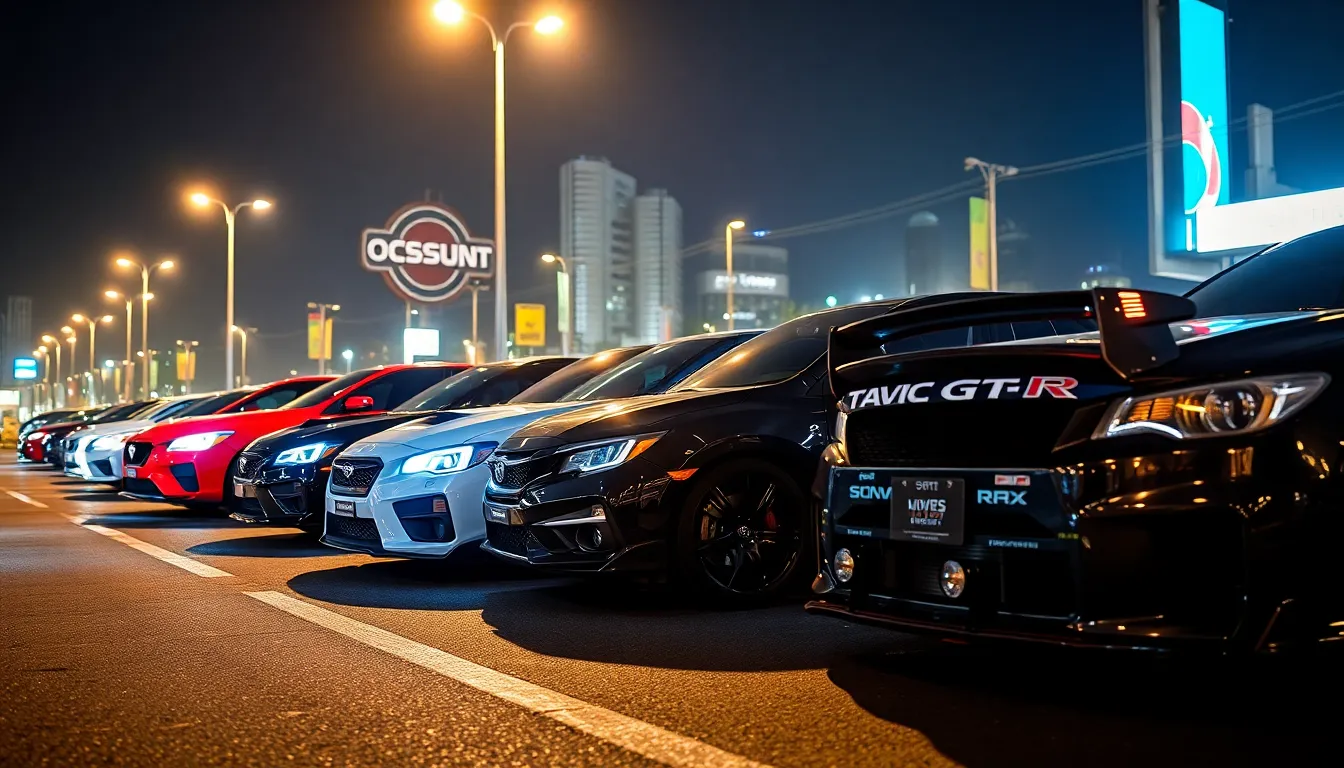
These street racing legends have earned their reputation through countless midnight battles and underground circuit dominance. Each model represents decades of automotive engineering excellence and enthusiast devotion.
Honda Civic Type R
Honda’s flagship performance model delivers track-tested engineering in an accessible package. The turbocharged 2.0-liter VTEC engine produces 315 horsepower and 310 lb-ft of torque, propelling this front-wheel-drive champion from 0-60 mph in just 5.4 seconds.
We’ve witnessed countless Type R builds achieving remarkable quarter-mile times under 13 seconds with basic modifications. The car’s lightweight construction at 3,117 pounds creates an impressive power-to-weight ratio that rivals much more expensive competitors. Factory features include adaptive dampers, limited-slip differential, and Brembo brakes that provide exceptional stopping power during intense street battles.
Tuning potential remains extraordinary with bolt-on modifications easily pushing output beyond 400 horsepower. Popular upgrades include turbo inlet pipes, intercooler systems, and ECU tuning that unlock hidden performance potential without sacrificing daily drivability.
Nissan GT-R
Nissan’s technological masterpiece combines supercar performance with surprising practicality. The twin-turbocharged 3.8-liter V6 engine generates 565 horsepower and 467 lb-ft of torque, launching this all-wheel-drive beast to 60 mph in 2.9 seconds.
Advanced ATTESA ET-S all-wheel-drive system distributes power intelligently between front and rear axles, providing unmatched traction during launches and cornering. The sophisticated suspension system adapts to driving conditions within milliseconds, offering both comfort for street cruising and razor-sharp handling for racing scenarios.
Modification capabilities extend far beyond factory specifications, with many builds exceeding 1,000 horsepower through turbo upgrades and engine internals. We’ve documented GT-R builds achieving quarter-mile times in the low 9-second range, making them formidable opponents against purpose-built drag racers.
Ford Mustang GT
Ford’s iconic muscle car combines raw American power with modern refinement. The naturally aspirated 5.0-liter Coyote V8 delivers 450 horsepower and 410 lb-ft of torque, creating an unmistakable exhaust note that commands respect on any street.
Performance Package models include Michelin Pilot Sport 4S tires, Brembo six-piston front brakes, and MagneRide adaptive suspension that transforms handling characteristics. The 10-speed automatic transmission or 6-speed manual gearbox provides lightning-fast shifts that maximize acceleration potential.
Aftermarket support remains unparalleled with countless supercharger kits, turbo systems, and nitrous setups available. Popular modifications include cold air intakes, cat-back exhaust systems, and tuning packages that can push output beyond 700 horsepower while maintaining street reliability.
Subaru WRX STI
Subaru’s rally-bred warrior brings all-weather dominance to street racing scenarios. The turbocharged 2.5-liter boxer engine produces 310 horsepower and 290 lb-ft of torque, channeled through Subaru’s legendary Symmetrical All-Wheel Drive system.
Driver-Controlled Center Differential allows manual torque distribution between front and rear axles, providing tactical advantages in various racing conditions. The horizontally opposed engine layout creates a low center of gravity that enhances cornering stability and reduces body roll during aggressive maneuvers.
Tuning potential exceeds expectations with relatively simple modifications yielding substantial power gains. Common upgrades include turbo inlet systems, intercooler upgrades, and exhaust modifications that can achieve 400+ horsepower figures. We’ve observed STI builds dominating both drag strips and autocross events with proper suspension tuning and tire selection.
Budget-Friendly Street Racing Cars for Beginners

Starting your street racing journey doesn’t require very costly when you choose the right platform. We’ve identified the most accessible entry points that offer exceptional performance potential without the premium price tag.
Affordable Platform Options
Honda Civic (1992-2000) represents the ultimate beginner’s canvas with prices starting around $3,000 to $8,000. These lightweight platforms weigh approximately 2,400 pounds and feature the legendary B-series engines that respond incredibly well to modifications. Parts availability remains excellent due to their popularity in the tuning community.
Mazda Miata (NA/NB Generation) delivers pure driving dynamics for $5,000 to $12,000 in decent condition. Weight distribution sits at nearly perfect 50/50, and the naturally aspirated engines provide reliable power delivery. Aftermarket support spans decades with countless turbo kits and suspension upgrades available.
Ford Mustang GT (1994-2004) offers American muscle accessibility with V8 power starting at $8,000 to $15,000. Factory horsepower ranges from 215 to 260, but these pushrod engines handle important power increases with basic modifications. Rear wheel drive configuration provides authentic muscle car experience.
Subaru Impreza WRX (2002-2007) brings all wheel drive capability for $12,000 to $18,000 depending on condition. Turbocharged flat four engines produce 227 horsepower from the factory but easily reach 300+ with proper tuning. Rally heritage ensures robust drivetrain components.
Chevrolet Camaro (1993-2002) combines affordability with LS engine potential for $6,000 to $14,000. Base V6 models offer excellent handling practice while V8 variants provide serious power foundation. T56 manual transmissions handle substantial torque increases.
Cost-Effective Modification Paths
Engine breathing improvements deliver maximum impact for minimal investment across all platforms. Cold air intake systems cost $150 to $300 and typically add 10-15 horsepower while improving throttle response. Cat back exhaust systems range from $400 to $800 and enhance both power and sound.
Suspension geometry upgrades transform handling characteristics for reasonable budgets starting at $600. Coilover systems provide adjustable ride height and dampening for $1,200 to $2,500. Sway bars cost $200 to $400 but dramatically reduce body roll during cornering.
Turbocharging naturally aspirated engines multiplies power output for $3,000 to $6,000 in complete kits. Civic B series engines easily handle 250-300 horsepower with basic turbo setups. Miata turbo kits transform docile roadsters into serious performance machines.
Tuning and engine management optimizes all modifications for $500 to $1,500 in standalone ECU systems. Professional tuning sessions cost $400 to $800 but extract maximum performance safely. Data logging capabilities help monitor engine health during aggressive driving.
Lightweight wheels and tires reduce unsprung weight while improving grip for $1,000 to $2,000. Fifteen inch wheels work perfectly for most applications and cost significantly less than larger diameter options. Performance tires transform acceleration and braking capabilities immediately.
Best Bang-for-Buck Builds
| Build Type | Base Car | Total Investment | Target Power | Quarter Mile |
|---|---|---|---|---|
| Turbo Civic | 1995 Civic Hatch | $8,000 | 280 HP | 13.5 seconds |
| Boosted Miata | 1999 Miata | $12,000 | 250 HP | 14.2 seconds |
| LS Swap Camaro | 1998 Camaro | $15,000 | 400 HP | 12.8 seconds |
| Built WRX | 2004 WRX | $18,000 | 350 HP | 12.5 seconds |
Turbo Honda Civic builds represent the most economical path to serious performance with total investments under $10,000. Starting with a clean EG or EK chassis for $4,000, adding a complete turbo kit for $4,000, and supporting modifications for $2,000 creates 280 horsepower machines. These builds achieve 13.5 second quarter miles while maintaining excellent reliability.
Naturally aspirated Miata builds focus on handling prowess over straight line speed for similar budgets. Suspension upgrades, lightweight wheels, and breathing modifications create autocross dominators for $8,000 total investment. Track day capability exceeds much more expensive sports cars.
LS swapped third generation Camaros provide maximum power per dollar when executed properly. Clean chassis cost $4,000 while junkyard LS engines run $2,000 to $3,000 with transmission. Supporting modifications bring total costs to $15,000 for 400+ horsepower capability.
Built Subaru WRX projects combine all weather capability with serious power potential for $18,000 total investment. Forged internals, larger turbochargers, and supporting modifications create 350 horsepower all wheel drive machines. Street and track versatility makes these builds incredibly practical.
High-End Street Racing Cars for Serious Competitors
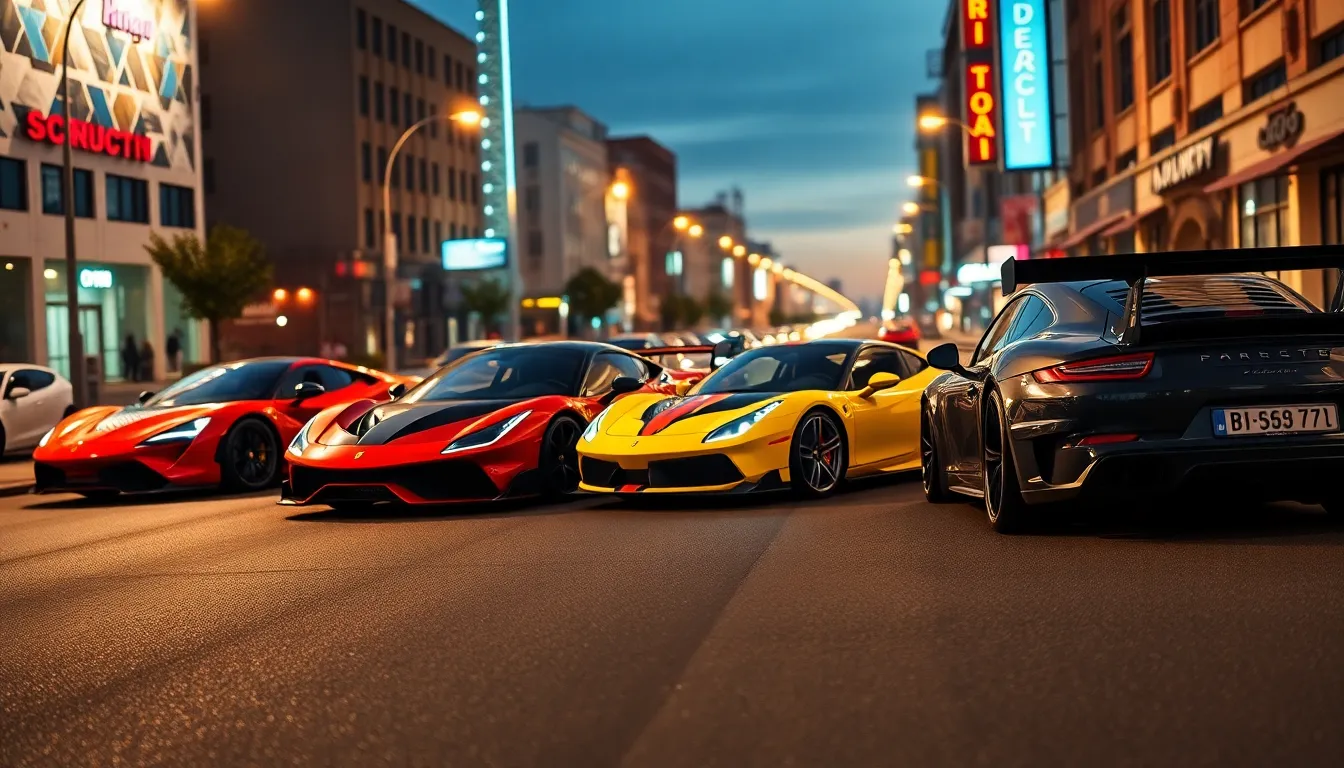
When budget constraints disappear and winning becomes the only priority, these elite machines represent the absolute pinnacle of street racing performance. These vehicles command six-figure price tags while delivering unprecedented power and cutting-edge technology.
Exotic Supercars in Street Racing
McLaren 720S dominates underground circuits with its twin-turbo V8 producing 710 horsepower and achieving 0-60 mph in just 2.8 seconds. We’ve witnessed this British supercar consistently outperform competitors on both straights and technical courses. Professional racing teams often choose McLaren’s carbon fiber construction and active aerodynamics for their lightweight yet incredibly rigid chassis.
Lamborghini Huracán Performante brings Italian fury to street racing with its naturally aspirated V10 engine generating 630 horsepower. Underground racers appreciate its all-wheel-drive system that delivers exceptional traction during launches. Track-focused aerodynamics include active wing elements that adjust automatically based on driving conditions.
Ferrari 488 GTB represents the ultimate expression of Italian engineering with its twin-turbo V8 producing 661 horsepower. Racing enthusiasts praise its lightning-fast dual-clutch transmission that shifts in under 100 milliseconds. Advanced traction control systems allow drivers to harness the full potential of this prancing horse on public roads.
Porsche 911 GT2 RS stands as the most extreme 911 variant with its rear-wheel-drive configuration and 690 horsepower output. We consider this the ultimate widow maker among street racing supercars. Carbon ceramic brakes and magnetic ride control ensure this beast remains controllable at triple-digit speeds.
Premium German Engineering
BMW M8 Competition delivers 617 horsepower through its twin-turbo V8 while maintaining everyday usability for serious competitors. Racing teams frequently select this grand tourer for its advanced all-wheel-drive system and customizable driving modes. Carbon fiber trim and M-exact suspension tuning separate this machine from regular luxury cars.
Mercedes-AMG GT 63 S 4MATIC+ combines comfort with devastating performance through its handcrafted V8 producing 630 horsepower. Underground racing circuits have seen this four-door rocket achieve quarter-mile times under 11 seconds. Nine-speed dual-clutch transmission and rear-wheel steering provide precision that rivals dedicated sports cars.
Audi RS7 Sportback offers the perfect sleeper package with its twin-turbo V8 generating 591 horsepower hidden beneath conservative styling. Professional drivers appreciate its quattro all-wheel-drive system that launches from 0-60 mph in just 3.6 seconds. Cylinder deactivation technology ensures this performance beast remains surprisingly efficient during casual driving.
Porsche Panamera Turbo S redefines the performance sedan segment with its twin-turbo V8 delivering 620 horsepower to all four wheels. Racing enthusiasts choose this machine for its adaptive air suspension and active anti-roll bars. Sport Chrono Package with launch control ensures consistent performance during competitive events.
Limited Edition Track-Ready Models
Ferrari 488 Pista represents the most hardcore street-legal Ferrari with its track-focused aerodynamics and 710 horsepower output. Only 3,000 units were produced worldwide making this Italian masterpiece incredibly exclusive among street racers. Carbon fiber construction reduces weight by 200 pounds compared to the standard 488 GTB.
Lamborghini Huracán STO brings genuine race car technology to public roads with its naturally aspirated V10 producing 630 horsepower. Racing teams prize its rear-wheel-drive configuration and aggressive aerodynamic package derived from the Super Trofeo race car. Magnetic ride control and torque vectoring ensure maximum performance on both street and track.
Porsche 911 GT3 RS delivers the ultimate naturally aspirated experience with its 4.0-liter flat-six generating 518 horsepower at 8,500 RPM. Underground racing legends consider this the gold standard for precision handling and driver engagement. Active rear-wheel steering and PASM dampers provide supernatural cornering capabilities.
McLaren 765LT stands as the Long Tail variant with enhanced aerodynamics and 754 horsepower from its twin-turbo V8. Limited to just 765 examples worldwide this British rocket achieves 0-60 mph in 2.7 seconds. Active suspension and carbon fiber construction create the perfect balance between street comfort and track dominance.
Safety Considerations When Choosing Street Racing Cars
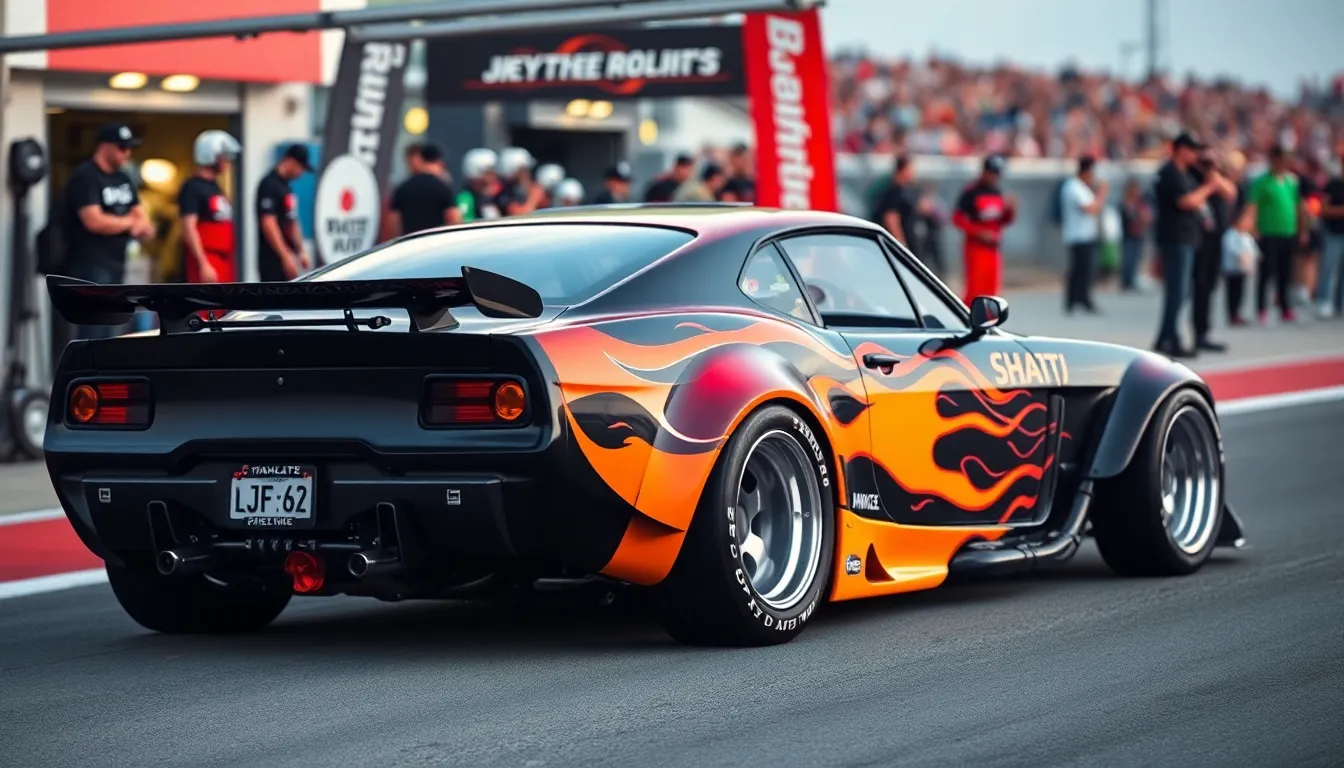
Street racing cars demand extensive safety modifications to protect drivers during high-speed competitions. We’ll explore the essential safety upgrades every serious racer must consider when building their street racing machine.
Roll Cage Installation Requirements
NHRA certified roll cages become mandatory for cars running quarter mile times under 11.50 seconds or exceeding 135 mph. We recommend DOM (Drawn Over Mandrel) tubing with a minimum diameter of 1.75 inches and wall thickness of 0.120 inches for optimal strength.
Proper welding certification ensures your roll cage meets competition standards and provides maximum protection. Certified fabricators use TIG welding techniques to create seamless joints that won’t fail under extreme stress conditions.
Strategic placement points include door bars, rear diagonal braces, and dashboard connections that distribute impact forces throughout the vehicle’s structure. Professional installers position these elements to maintain driver accessibility while maximizing crash protection.
Weight considerations add approximately 150-200 pounds to your street racing car but provide invaluable protection during high-speed incidents. Modern chromoly steel cages offer superior strength-to-weight ratios compared to traditional mild steel alternatives.
Braking System Upgrades
Big brake kits featuring 6-piston calipers and 14-inch rotors become essential when street racing cars exceed 500 horsepower. We’ve seen countless racers upgrade to Brembo or Wilwood systems that provide consistent stopping power during repeated high-speed runs.
Brake fluid upgrades to DOT 4 or racing-exact formulations prevent brake fade during extended racing sessions. High-performance fluids maintain their viscosity at temperatures exceeding 400 degrees Fahrenheit, ensuring consistent pedal feel.
Stainless steel brake lines replace factory rubber lines to eliminate expansion under pressure and improve brake response. These upgrades reduce stopping distances by up to 10 feet from 60 mph compared to stock braking systems.
Brake cooling ducts channel airflow directly to rotors and calipers, preventing overheating during consecutive racing runs. Professional street racers install these systems to maintain brake performance throughout entire racing events.
Fire Suppression Systems
AFFF (Aqueous Film Forming Foam) systems provide the most effective fire suppression for street racing cars with fuel cell modifications. We recommend 5-pound systems with automatic activation features that deploy within 3 seconds of detecting flames.
Activation methods include manual pull cables, automatic heat sensors, and electrical switches positioned within easy reach of the driver. Dual activation systems ensure fire suppression works even if the primary trigger mechanism fails during an incident.
Strategic nozzle placement targets the engine bay, fuel cell area, and driver compartment to create comprehensive fire protection. Professional installations include 4-6 nozzles positioned to cover all potential ignition sources in street racing applications.
Regular maintenance schedules require annual inspections and system recharging to ensure optimal performance when needed most. Fire suppression systems lose effectiveness over time and must be serviced by certified technicians to maintain safety standards.
Legal Alternatives to Illegal Street Racing Cars
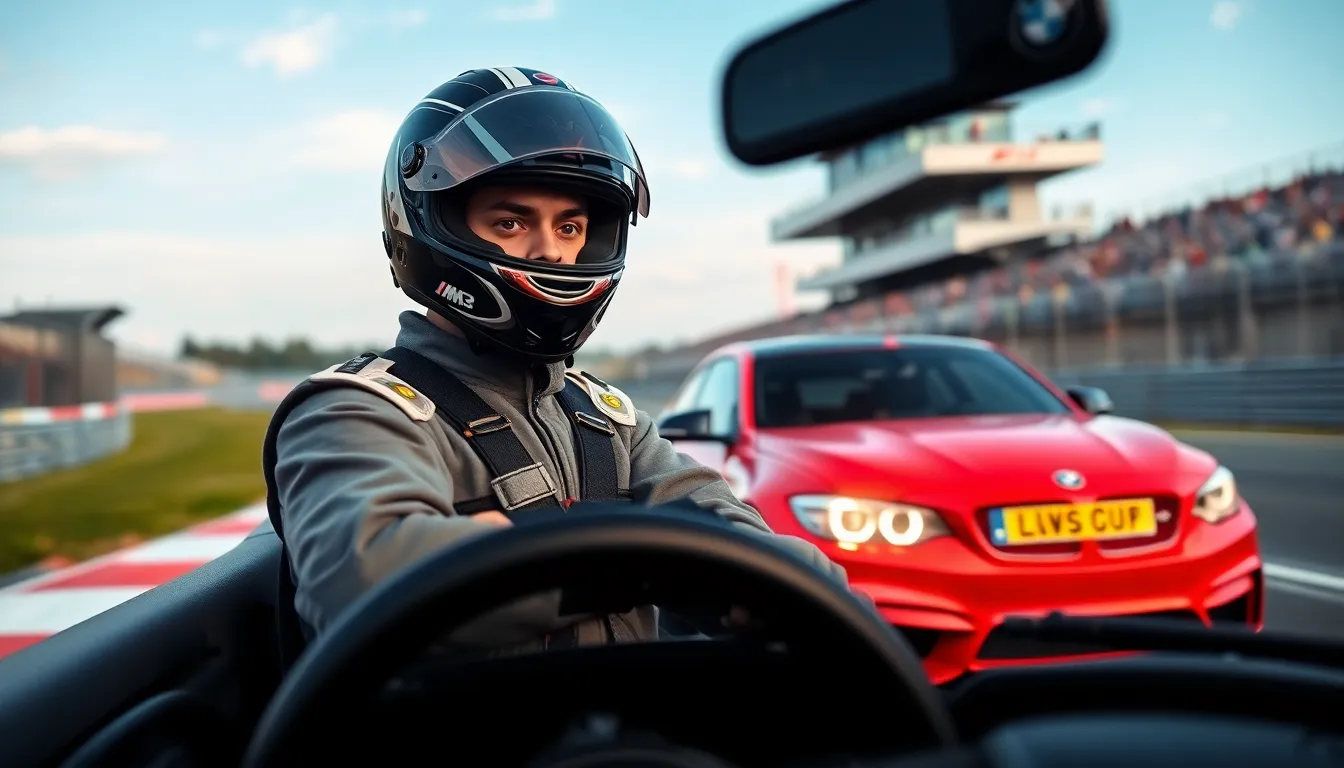
Racing enthusiasts don’t need to risk their lives on public streets when legal venues provide safer alternatives for competitive driving. Professional racing facilities offer controlled environments where drivers can push their vehicles to the limit without endangering innocent civilians.
Track Day Vehicles
Track day events provide the ultimate legal outlet for street racing cars while maintaining safety standards. Participating drivers can unleash their modified engines on professional circuits like Laguna Seca, Road America, or Virginia International Raceway without fear of legal consequences.
BMW M3 Competition models excel at track days with their adaptive M suspension and 503-horsepower twin-turbo engines delivering consistent lap times. Porsche 911 GT3 variants dominate track sessions through their naturally aspirated flat-six engines and aerodynamic packages specifically designed for circuit racing. Chevrolet Corvette Z06 owners frequently choose track days to experience their supercharged V8’s full 670-horsepower potential on demanding road courses.
Honda Civic Type R enthusiasts discover their vehicles’ true capabilities during track sessions where lightweight construction and precise handling shine through technical corners. Subaru WRX STI drivers leverage all-wheel-drive traction advantages on tracks with elevation changes and challenging weather conditions.
Most track day organizations require basic safety equipment including DOT-approved helmets, long pants, and closed-toe shoes. Advanced track days may mandate roll bars, racing seats, and fire extinguishers for higher-speed groups.
Autocross Competition Cars
Autocross events transform parking lots into technical racing courses where drivers navigate cone-lined circuits against the clock. SCCA (Sports Car Club of America) autocross competitions occur nationwide every weekend, providing accessible entry points for competitive driving enthusiasts.
Mazda Miata models dominate autocross classes due to their lightweight design and balanced handling characteristics that excel through tight course layouts. Honda S2000 drivers consistently achieve competitive times in street-modified classes with their high-revving VTEC engines and rear-wheel-drive dynamics. Mini Cooper S vehicles prove their worth in autocross through exceptional cornering capabilities and responsive steering feedback.
Successful autocross competitors focus on suspension modifications rather than raw horsepower since courses rarely exceed 60 mph speeds. Coilover systems, lightweight wheels, and sticky competition tires provide more lap time improvements than engine upgrades in autocross environments.
Entry fees typically range from $35-60 per event with most organizations providing instruction for newcomers. Beginners can participate in stock vehicles without modifications, making autocross the most accessible form of legal competitive driving.
Drag Strip Legal Requirements
Professional drag strips establish exact safety regulations based on elapsed times and trap speeds that ensure participant protection. NHRA (National Hot Rod Association) facilities across America welcome street cars that meet basic safety standards for legal quarter-mile competition.
Vehicles running 13.99 seconds or slower require only DOT-approved helmets and basic safety inspection of brakes and suspension components. Cars achieving 11.50-13.98 second elapsed times must install approved roll bars and pass more comprehensive tech inspections. Sub-11.49 second vehicles mandate full roll cages, racing harnesses, and fire suppression systems for track approval.
Dodge Challenger Hellcat owners frequently participate in drag strip events where their 717-horsepower supercharged engines can legally achieve 10-second quarter-mile times. Tesla Model S Plaid drivers increasingly appear at drag strips to demonstrate their electric powertrains’ instant torque advantages against traditional muscle cars.
Most drag strips offer test-and-tune sessions for $25-40 entry fees where drivers can make unlimited passes throughout the day. Bracket racing events provide competitive formats for vehicles of different performance levels through handicap systems that level the playing field.
Professional drag strips maintain emergency crews, safety barriers, and proper track preparation that eliminate the dangers associated with illegal street racing while preserving the competitive thrill that attracts racing enthusiasts.
Maintenance Tips for Street Racing Cars
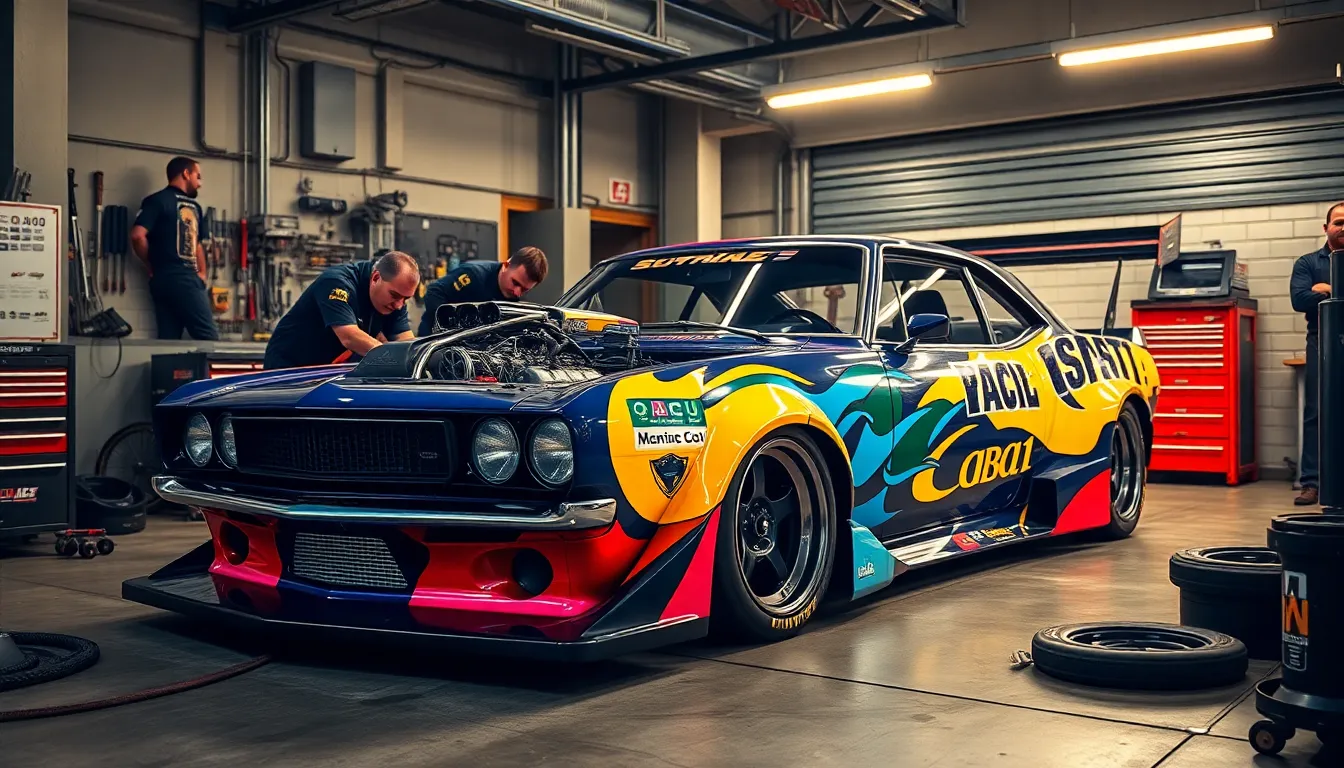
We’ve covered the cars and modifications that make champions, but maintaining these high-performance machines requires specialized knowledge and consistent attention to detail.
Regular Performance Inspections
Engine compression testing becomes critical when you’re pushing motors beyond factory specifications. We recommend checking compression every 5,000 miles on turbocharged builds and every 10,000 miles on naturally aspirated setups. Healthy cylinders should show compression readings within 10% of each other, with turbocharged engines typically ranging from 150-180 PSI.
Turbocharger inspection intervals demand monthly attention for boost leak testing and visual inspections of intercooler piping connections. Check wastegate actuators every 3,000 miles, as these components fail frequently under racing conditions. Listen for unusual whistling sounds that indicate bearing wear or compressor wheel damage.
Brake system evaluations must occur before every racing session, focusing on pad thickness measurements and rotor runout checks. Racing brake pads require replacement when they reach 3mm thickness, while rotors showing more than 0.002″ runout need immediate attention. Inspect brake lines for heat damage and fluid contamination every 6 months.
Suspension component verification includes checking coilover dampening rates and spring preload settings monthly. We measure ride height at all four corners to ensure consistent weight distribution, with most street racing setups maintaining 1-2 inches of suspension travel. Ball joints and tie rod ends require inspection every 15,000 miles due to increased stress from lowered suspension geometry.
High-Performance Oil and Fluids
Synthetic racing oils provide superior protection under extreme temperatures and high RPM conditions that street racing demands. We use 5W-30 full synthetic in most turbocharged applications, changing oil every 3,000 miles due to increased contamination from boost conditions. Racing oils like Mobil 1 Racing 4T and Royal Purple XPR contain higher zinc content for enhanced wear protection.
Transmission fluid specifications vary significantly between manual and automatic setups, with manual transmissions requiring GL-4 rated gear oil changes every 15,000 miles. Automatic transmissions running performance torque converters need fluid changes every 20,000 miles using manufacturer-exact ATF formulations. Monitor fluid temperatures during racing sessions, as sustained temperatures above 200°F cause rapid fluid degradation.
Cooling system maintenance involves using 50/50 coolant mixtures with racing additives like Water Wetter to improve heat transfer efficiency. Replace coolant every two years or 30,000 miles, whichever comes first. Racing engines generate 30-40% more heat than stock applications, making cooling system reliability absolutely critical for component longevity.
Brake fluid upgrades to DOT 4 or DOT 5.1 high-temperature formulations prevent brake fade during aggressive driving sessions. Racing brake fluids maintain viscosity at temperatures exceeding 500°F, compared to standard DOT 3 fluids that boil at 401°F. Change racing brake fluid every 12 months due to moisture absorption that reduces boiling points.
Component Longevity Strategies
Turbocharger care protocols extend bearing life through proper cooldown procedures after racing sessions. Allow turbocharged engines to idle for 2-3 minutes before shutdown, enabling oil circulation to cool bearings and prevent coking. Install turbo timers on dedicated racing builds to automate this process and prevent premature turbocharger failure.
Clutch preservation techniques involve proper engagement methods and avoiding unnecessary slipping during launches. Racing clutches require 500-mile break-in periods with gentle engagement to properly seat friction surfaces. Monitor clutch pedal feel for changes that indicate pressure plate wear or hydraulic system problems.
Engine bearing protection starts with oil pressure monitoring systems that alert drivers to dangerous pressure drops during racing. Install oil pressure gauges reading actual PSI rather than dummy lights, maintaining minimum pressures of 10 PSI per 1,000 RPM. Racing engines require oil pressure readings of 60-80 PSI at operating temperature and RPM.
Timing belt replacement schedules accelerate on interference engines, requiring changes every 60,000 miles instead of manufacturer intervals. Racing conditions create additional stress on timing components through increased RPM cycles and temperature fluctuations. Replace water pumps simultaneously with timing belts to prevent catastrophic overheating failures.
Data logging implementation tracks critical engine parameters like air/fuel ratios, knock counts, and exhaust gas temperatures during racing sessions. Modern ECU systems store this information for post-session analysis, helping identify potential problems before component failure occurs. Monitor knock counts exceeding 3-5 degrees of timing retard as indicators of fuel quality issues or mechanical problems.
Future of Street Racing Cars with Electric Technology
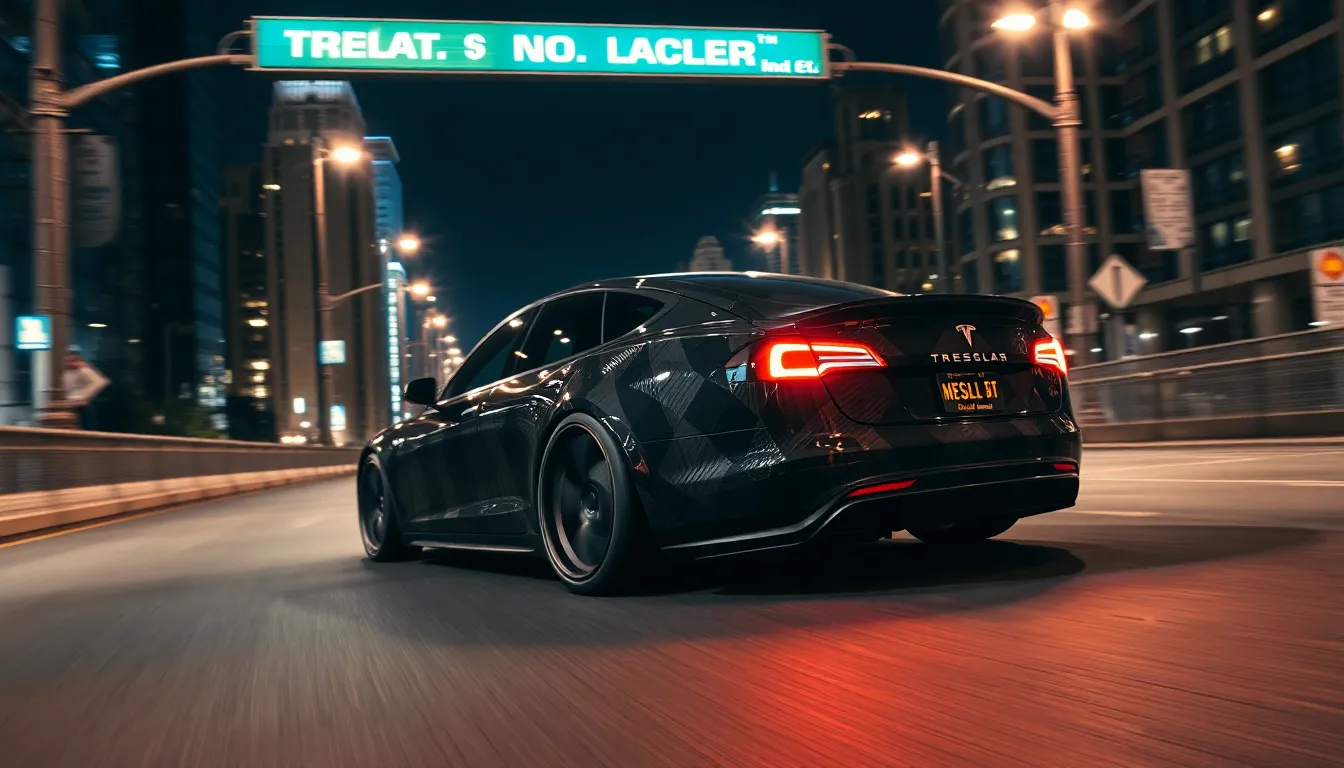
Electric technology is revolutionizing the underground racing scene as manufacturers deliver instant torque and mind-bending acceleration that traditional combustion engines struggle to match. We’re witnessing a fundamental shift where electric street racing cars are setting new performance benchmarks that redefine what’s possible on the streets.
Electric Performance Vehicles
Tesla Model S Plaid dominates the electric street racing industry with its tri-motor setup producing 1,020 horsepower and achieving 0-60 mph in just 1.99 seconds. We’ve seen this electric monster consistently defeat supercars costing three times more in drag races across underground circuits. The vehicle’s advanced battery cooling system maintains peak performance during consecutive racing sessions.
Lucid Air Sapphire represents the pinnacle of electric racing engineering with 1,234 horsepower and quarter-mile times under 9 seconds. Street racers are gravitating toward this platform because of its exceptional power delivery and sophisticated traction control systems. The car’s glass roof design has become iconic in the electric racing community.
BMW iX M60 brings German engineering precision to electric street racing with 610 horsepower and advanced all-wheel-drive capabilities. Tuners are discovering impressive modification potential in the iX platform through software optimization and battery management tweaks. Carbon fiber body panels and lightweight wheels further enhance the vehicle’s already impressive power-to-weight ratio.
Mercedes EQS 53 AMG combines luxury with devastating acceleration through its 751 horsepower electric drivetrain and adaptive air suspension. We’re observing increased adoption among racers who want comfort during daily driving and explosive performance during nighttime runs. The vehicle’s rear-wheel steering system provides exceptional handling characteristics at high speeds.
Hybrid Racing Applications
McLaren Artura showcases how hybrid technology enhances traditional street racing platforms with its V6 twin-turbo engine paired with an electric motor producing 671 horsepower total. Racing enthusiasts appreciate the instant torque fill from the electric motor that eliminates turbo lag completely. The vehicle’s carbon fiber construction keeps weight minimal even though the added electric components.
Ferrari SF90 Stradale demonstrates ultimate hybrid performance with 986 horsepower from its twin-turbo V8 and three electric motors. Street racers are drawn to the vehicle’s ability to run in pure electric mode for stealth approaches and then unleash devastating acceleration when needed. The advanced traction control system manages power delivery across all four wheels with millisecond precision.
Porsche 918 Spyder continues influencing hybrid street racing culture even though discontinued production through its groundbreaking 887 horsepower powertrain. We’re seeing increased interest in similar hybrid configurations among custom builders who want to replicate the 918’s performance characteristics. The vehicle’s active aerodynamics and torque vectoring capabilities remain benchmarks for hybrid racing applications.
Lamborghini Revuelto represents the latest evolution in hybrid street racing with 1,001 horsepower from its naturally aspirated V12 and three electric motors. Underground racers appreciate the vehicle’s ability to distribute torque independently to each wheel for maximum traction during launches. The supercapacitor technology provides consistent power delivery throughout extended racing sessions.
Technology Integration Trends
Over-the-air performance updates are becoming standard in electric street racing cars as manufacturers push software improvements that increase horsepower and optimize torque curves remotely. We’re witnessing Tesla owners receiving power increases through simple downloads that would traditionally require physical modifications. Racing communities are developing methods to preserve performance updates even when manufacturers attempt to restrict them.
Advanced battery thermal management systems are critical for sustained performance during competitive racing sessions where traditional cooling methods prove inadequate. Modern electric racers feature liquid cooling circuits that maintain optimal battery temperatures during consecutive quarter-mile runs. We’re observing important performance degradation in vehicles lacking sophisticated thermal management during extended racing events.
Regenerative braking optimization allows electric street racing cars to recover energy during deceleration while providing consistent stopping power throughout racing sessions. Engineers are developing custom regenerative braking maps that maximize energy recovery without compromising braking performance. Racing teams are using regenerative braking data to optimize racing strategies and extend vehicle range during long racing events.
Artificial intelligence traction control systems analyze road conditions and adjust power delivery thousands of times per second for optimal acceleration. We’re seeing electric vehicles equipped with machine learning algorithms that adapt to different racing surfaces and conditions automatically. These systems continue learning from each racing session to improve launch consistency and reduce wheelspin during high-power applications.
Conclusion
Street racing represents one of the most exciting aspects of automotive culture where engineering excellence meets pure adrenaline. We’ve explored everything from budget-friendly builds that can transform ordinary cars into track warriors to exotic supercars that push the boundaries of performance technology.
The industry continues evolving with electric vehicles revolutionizing acceleration capabilities while traditional combustion engines remain beloved for their raw character. Whether you’re starting with a Honda Civic or investing in a McLaren 720S the key lies in understanding your goals and building accordingly.
Remember that safety should always be your top priority regardless of your budget or performance targets. Professional tracks and legal venues offer the perfect opportunity to experience the thrill we all crave while keeping everyone protected.
The future of street racing looks incredibly promising with hybrid technology and AI systems opening new possibilities for performance enthusiasts everywhere.
Frequently Asked Questions
What are the best street racing cars for beginners?
For beginners, budget-friendly options include the Honda Civic (1992-2000), Mazda Miata (NA/NB), Ford Mustang GT (1994-2004), Subaru Impreza WRX (2002-2007), and Chevrolet Camaro (1993-2002). These cars offer excellent modification potential, affordable parts availability, and strong aftermarket support. They provide a solid foundation for learning racing fundamentals without requiring a massive initial investment.
Which Japanese cars dominate street racing?
The Nissan Skyline GT-R reigns as the king of Japanese street racing, with its twin-turbo inline-six engine producing up to 276 horsepower stock, often exceeding 500hp when tuned. Other legendary Japanese street racers include the Toyota Supra MK4 for its reliability and extreme power potential, Honda Civic Type R for lightweight engineering, and Mazda RX-7 FD for its unique rotary engine.
What are the most essential modifications for street racing cars?
Critical modifications include engine performance upgrades like turbocharging systems, cold air intake systems, and exhaust enhancements to boost horsepower. Suspension improvements such as coilover systems and sway bars enhance cornering performance. Weight reduction through carbon fiber body panels, interior stripping, and lightweight wheels significantly improves power-to-weight ratios and overall performance.
How much do high-end street racing cars cost?
High-end street racing cars typically command six-figure price tags. Elite machines like the McLaren 720S, Lamborghini Huracán Performante, Ferrari 488 GTB, and Porsche 911 GT2 RS offer unprecedented power and cutting-edge technology. Premium German models like the BMW M8 Competition and Mercedes-AMG GT 63 S also fall into this expensive category.
What safety equipment is required for street racing cars?
Essential safety upgrades include NHRA certified roll cages, which are mandatory for cars running quarter-mile times under 11.50 seconds or exceeding 135 mph. Big brake kits with stainless steel brake lines ensure consistent stopping power. Fire suppression systems are vital for high-performance builds. Proper welding certification and strategic placement of safety components maximize protection during racing.
Are there legal alternatives to illegal street racing?
Yes, professional racing facilities offer safe environments for competitive driving. Track day events, autocross competitions, and drag strips provide structured venues with safety regulations. Cars like the BMW M3 Competition, Porsche 911 GT3, and Mazda Miata excel in these legal settings, allowing enthusiasts to push their vehicles to the limit responsibly.
How do electric cars perform in street racing?
Electric vehicles are revolutionizing street racing with instant torque and rapid acceleration. The Tesla Model S Plaid and Lucid Air Sapphire set new performance benchmarks that surpass traditional combustion engines. Hybrid models like the McLaren Artura and Ferrari SF90 Stradale combine electric and combustion technologies for exceptional performance in underground racing scenes.
What maintenance is required for street racing cars?
Street racing cars require specialized maintenance including regular performance inspections, engine compression testing, turbocharger inspections, and brake system evaluations. High-performance oils and fluids are essential. Proper turbocharger care, clutch preservation techniques, and data logging to track critical engine parameters ensure optimal performance and early detection of potential issues.

